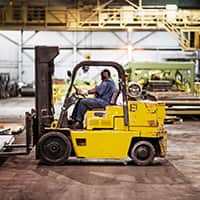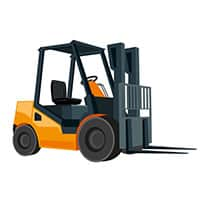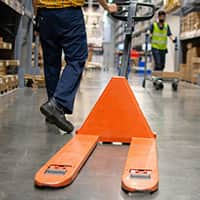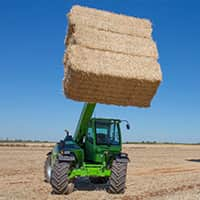What Are the Different Kinds of Forklifts and the Training Required to Drive Them?
Written by Staff Writer | Edited by Nate Bortz

Powered industrial trucks (PITs), commonly called forklifts, are powerful machines used in a variety of applications to help lift and move materials. Anyone working on construction sites has likely encountered a forklift. They are also commonly found in warehouses, larger retail businesses and other environments where heavy lifting is necessary.
The Occupational Health and Safety Administration (OSHA) has specific safety requirements for the operation of PITs. PIT training is required for workers who operate these machines for safety reasons. This training must include formal instruction, practical training and an evaluation.
This guide will help workers understand the different types of forklifts and their classifications, as well as the training required to operate them.
OSHA’s Powered Industrial Truck Classifications
OSHA divides PITs into seven classifications:
- Class I: Electric motor rider trucks
- Class II: Electric motor narrow aisle trucks
- Class III: Electric motor hand trucks or hand/rider trucks
- Class IV: Internal combustion engine trucks (solid/cushion tires)
- Class V: Internal combustion engine trucks (pneumatic tires)
- Class VI: Electric and internal combustion engine tractors
- Class VII: Rough terrain forklift
Each category has specific features and applications that make it stand out from the others, although there can be some overlap.
Class I: Electric motor rider PITs
For many people, rider PITs are what they picture when they imagine a forklift. Most of these PITs feature a seat and steering wheel so the user can sit and operate the vehicle. However, there are also standing models.
These rider PITs have electric motors, which means they are relatively quiet and don’t produce exhaust emissions. However, they do require charging.
Class II: Electric motor narrow aisle trucks
These PITs are narrow to fit down aisles and are commonly used in retail and warehouse applications. This type utilizes electrical motors. They are excellent for picking inventory from warehouse shelving and similar applications where space is tight.
Class III: Electric motor hand trucks or hand/rider trucks
These use electrical power in configurations that include stackers, pallet jacks and smaller tow tractors. Some can be ridden, while others are designed to be walked behind. Operators can use these to move loaded pallets and stack and tow loads to staging areas. Once they deliver the loads to staging areas, other PIT operators (such as those using rider PITs) place the loads in their final positions.
Class IV: Internal combustion engine trucks (solid/cushion tires)
These PITs are often quite similar to the first classification of PITs, just with internal combustion engines instead of electric motors. Operators are usually seated and use a steering wheel to navigate with the vehicle. They feature solid tires that are appropriate for indoor use. They provide a smooth ride while being puncture-proof and durable.
PITs with internal combustion engines can run on various fuels, depending on the model. Fuels can include diesel, gasoline, liquid propane and compressed natural gas. Propane forklifts with solid tires fall under Class IV, just like gasoline versions.
Class V: Internal combustion engine trucks (pneumatic tires)
These PITs are similar to those in Class IV, but they utilize pneumatic tires which makes them better for outdoor use. While a warehouse might use a Class IV model, a construction site might use this model.
Class VI: Electric and internal combustion engine tractors
This type of PIT is often found at airports and assembly lines. They are used to tow loads from one location to another. Both electric and internal combustion models are considered Class VI.
Class VII: Rough terrain forklift
These PITs feature big tires, similar to tractor tires, making them ideal for outdoor applications. Rough terrain forklifts are almost always powered by diesel engines, like tractors and other vehicles that need to generate lots of power in rough terrain. They are mostly found on construction sites, lumberyards and similar worksites.
The Most Common Forklift Types and Their Uses
OSHA forklift training requires workers to understand the different official classifications of PITs. However, it can also be helpful to know the most common forklift types and how they are used in workplace applications.
These include:
Counterbalance
This type of forklift is the standard that many people are familiar with. Counterbalance forklifts use a weight at the back of the vehicle to counterbalance the weight of the load being lifted. There are many different models in this category, ranging from fairly small lifts for handling pallets to large, heavy-duty lifts that can move 100,000 pounds or more.

Reach
Reach forklifts are designed for use in tighter spaces, like warehouse aisles. These have a small turning radius and a long mast to reach high shelves for storing and retrieving pallets and other items.
Pallet Jack
A pallet jack, sometimes called a pump truck, is a relatively small and light machine compared to counterbalance designs. This type of lift transfers pallets around an indoor space like a factory or warehouse.

Rough Terrain
A rough terrain lift is designed to operate on gravel, mud, dirt and other uneven surfaces. Its big, knobby tires and strong engine allow it to lift and move loads across difficult terrain.
Telescopic Handler
A telescopic handler is a fairly unique kind of lift due to its telescoping boom. It can reach out from the vehicle to move loads from a distance. This type of PIT is designed for construction work and is also commonly found in agricultural settings.

Side Loader
Side loaders are another small, compact type of lift that is used in aisles and other tight spaces. The lift is located on the side of the vehicle, instead of on the front, which makes it possible to lift loads in narrow aisles and move them forward or backward without needing to turn.
Order Picker
Order pickers let the operator lift themselves up to high warehouse shelves to pick items. It’s commonly found in order fulfillment businesses and other operations where operators need to get up close to identify what they need.
OSHA Training and Certification Programs
Regulators require anyone who operates a PIT to gain certification for their safety and for the safety of everyone around them. OSHA-accepted certification courses teach the uses and applications of various forklift types. They also provide instructions on the safety protocols required to operate PITs safely.
Many PITs are small enough to make the average person assume they are fun and easy to operate. While operating machinery can be enjoyable, it’s important to understand that even the smallest PITs are still capable of causing serious injury or death. That’s why OSHA requires every employer to provide safety training for operators.
As a leading provider of OSHA-accepted safety training courses, OSHA Education Center is the ideal resource for forklift certification training.
Available courses include:
- Forklift Certification: Covers appropriate uses of different types of lifts, operational procedures and the importance of regular inspection and maintenance
- Aerial and Scissor Lifts: Teaches the importance of safety procedures during and after use, types of aerial and scissor lifts, applicable OSHA standards and more
- Pallet Jack Certification: Instruction for manual and electric pallet jacks, measures to reduce accidents, inspection procedures and more
- Telehandler Certification: Explains hazard prevention, safe telehandler maneuvering and pre-operation inspections.
Regulations require operators to go through three stages of education to be eligible to operate a forklift:
- Formal training
- Practical training
- Performance evaluation
These courses fulfill the first stage of the training process and prepare operators for the final two stages. With a completed course under their belts, operators are well-equipped to go through their employer’s practical training and performance evaluation.
For those planning on applying to PIT operator positions, it can be helpful to have completed a safety course to stand out to employers. OSHA Education Center courses simplify this process by making the education process as streamlined as possible.
Why Choose OSHA Education Center?
OSHA Education Center is the top choice for safety education courses for multiple reasons. The online courses are designed to fit into busy lives. Students can get the safety education they need on their schedule.
Other benefits include:
- Flexibility: Complete coursework using any internet-connected device
- Courses are self-paced and all progress is saved automatically
- Students have 90 days to complete a course
- Downloadable certificates of completion are available immediately
- PIT certification courses include a plastic, wallet-sized certificate card upon completion*
Anyone interested in PIT safety training can sign up for a course today and start their education at their convenience.
*The Aerial and Scissor Lifts course does not provide an OSHA-accepted certification or certification card. While aerial and scissor lifts are currently covered under OSHA scaffolding standards, OSHA plans to transition them to the PIT standard in the future.
